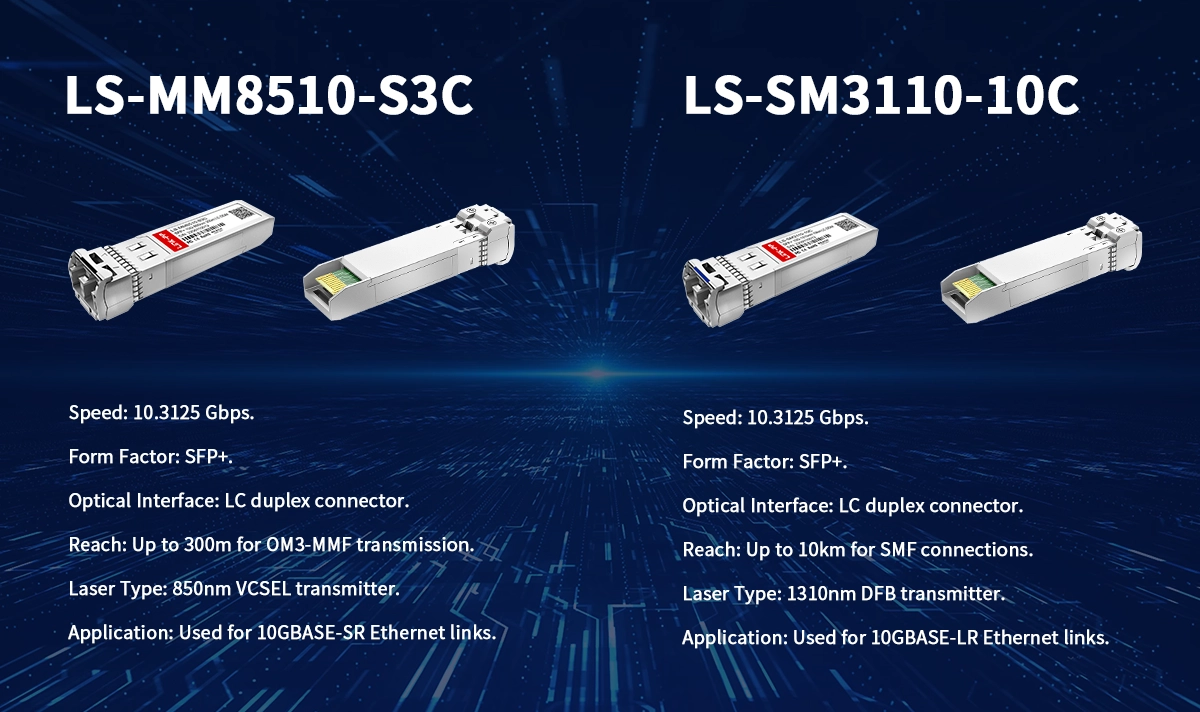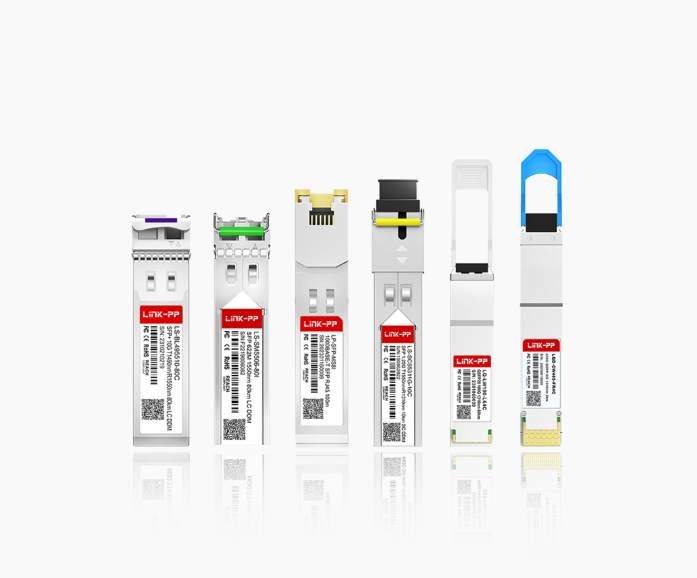
In the high-speed world of 10 Gigabit networking, the SFP+ (Enhanced Small Form-factor Pluggable) transceiver is the unsung hero. These compact modules are the critical interface between your networking equipment and the fiber optic cable, defining the speed, distance, and reliability of your data links. However, not all 10G SFP+ modules are created equal. The most fundamental choice you'll face is between short-range (SR) and long-range (LR) optics.
Selecting the wrong one can lead to network failure or unnecessary expense. This guide will demystify the long-range vs short-range SFP+ debate, helping you make an informed decision that optimizes your network's performance and budget. We'll also explore how choosing a quality manufacturer, like LINK-PP, ensures long-term stability.
📝 Key Takeaways
Pick long-range 10g sfp+ modules for up to 10 kilometers. Use single-mode fiber for these modules. They work well in big buildings or campus networks.
Use short-range 10g sfp+ modules for up to 400 meters. These use multimode fiber. They save money for small networks or data centers.
Make sure the sfp+ module matches your network’s distance and fiber type. This helps your network work well and saves money.
Think about your budget when you choose modules. Short-range modules usually cost less. They are good for smaller setups.
Plan for future needs by picking modules that can grow with your network. Long-range modules give you more choices for bigger networks.
📝 The Core Difference: It's All About the Light
The primary distinction between SR and LR modules lies in the type of laser technology and the wavelength of light they use. This fundamental difference dictates their transmission distance and application.
Short-Range (10GBASE-SR): Uses a 850nm VCSEL (Vertical-Cavity Surface-Emitting Laser) laser. VCSELs are cost-effective and perfect for short-distance transmission over multimode fiber (MMF).
Long-Range (10GBASE-LR): Uses a 1310nm DFB (Distributed Feedback Laser) laser. DFB lasers are more precise and powerful, designed for long-haul transmission over single-mode fiber (SMF).
Think of it like this: A VCSEL is a floodlight, brilliant for lighting up a wide, short area (multimode fiber's larger core). A DFB laser is a laser pointer, a focused beam that can travel a long, straight path without dispersing (single-mode fiber's tiny core).
📝 Head-to-Head Comparison: SR vs. LR SFP+ Modules
The table below provides a clear, at-a-glance comparison of these two dominant 10G SFP+ types.
Feature | 10GBASE-SR (Short-Range) | 10GBASE-LR (Long-Range) |
|---|---|---|
**Transmission Distance ** | Short (up to 400m on OM4 MMF) | Long (up to 10km on SMF) |
Fiber Type | Multimode Fiber (MMF - OM3/OM4) | Single-Mode Fiber (SMF) |
Laser Type | 850nm VCSEL | 1310nm DFB |
Typical Use Case | Data Center Racks, LANs, Intra-Building | Campus Networks, MANs, ISP Backbones |
Power Consumption | Lower | Higher |
Relative Cost | Lower (Module & Cable) | Higher (Module & Cable) |
Key Advantage | Cost-effectiveness for short links | Performance and reach over long distances |

Choosing Your Champion: Application is Key 🗝️
Your choice should be dictated by the specific requirements of your network link.
Choose a 10GBASE-SR Module if:
You are connecting equipment within a single data center rack or between adjacent racks.
Your building's internal network (LAN) is wired with multimode fiber (typically orange or aqua-colored cables).
Cost is a primary driver, and you don't foresee needing distances beyond 400 meters.
You are looking for a high-quality, compatible 10G multimode SFP+ for local server connectivity.
Choose a 10GBASE-LR Module if:
You need to connect two buildings across a campus or metropolitan area.
Your existing fiber infrastructure is single-mode (typically yellow-colored cables).
Future-proofing is important, as single-mode fiber can support much higher speeds over the same distance in the future.
You require a reliable 10G single-mode transceiver for connecting to an Internet Service Provider's (ISP) network.
📝 A Closer Look at the SFP+ Module: More Than Just a "Dongle"
Understanding the internal components of an SFP+ optical transceiver can further clarify why the SR/LR distinction matters. A quality module, like those from LINK-PP, isn't just a simple connector; it's a sophisticated electro-optical assembly.
The key components include:
The Laser Diode: The heart of the module, as discussed above.
The Optical Sub-Assembly: Converts electrical signals from the switch into light pulses (TOSA) and converts incoming light back into electrical signals (ROSA).
The Controller Chip: A vital component that manages the laser's power, temperature, and data signal integrity. It also houses the DDM/DOM (Digital Diagnostic Monitoring) functionality.
This brings us to a critical point for network engineers: DDM/DOM. This feature allows you to monitor real-time parameters like temperature, optical output power, and received power. This is invaluable for network troubleshooting and planning, allowing you to detect a failing fiber optic transceiver before it causes an outage. When selecting compatible 10G SFP+ optics, ensuring they are fully compliant with MSA (Multi-Source Agreement) standards and offer robust DDM support is non-negotiable for enterprise-grade reliability.
For instance, the LINK-PP SFP-10G-LR module is a prime example of a high-performance, MSA-compliant long-range transceiver. It guarantees a stable 10km link over single-mode fiber with comprehensive DDM data, making it an excellent budget-friendly 10G SFP+ solution without compromising on quality or features. Similarly, their LINK-PP SFP-10G-SR model provides exceptional value for data center deployments over OM3/OM4 fiber.
📝 Final Verdict and Your Next Steps
There is no "winner" in the SR vs. LR debate—only the right tool for the job.
For cost-sensitive, short-reach applications: 10GBASE-SR with multimode fiber is the undisputed champion.
For long-distance, future-proof backbone links: 10GBASE-LR with single-mode fiber is the only viable choice.
Pro Tip: Always audit your existing fiber plant before purchasing transceivers. Knowing your cable type (multimode or single-mode) and its condition is the first and most crucial step.
Ready to optimize your 10G network with reliable, high-performance transceivers?
Don't let a simple component choice become a network bottleneck. Explore our extensive range of fully compatible LINK-PP 10G SFP+ modules, including the SFP-10G-SR and SFP-10G-LR, designed for maximum performance and reliability.
➡️ Contact our experts today for a personalized recommendation!
📝 FAQ
What is the main difference between SFP-10G-SR and SFP-10G-LR modules?
You use SFP-10G-SR for short distances, usually up to 300 or 400 meters, with multimode fiber. You use SFP-10G-LR for longer distances, up to 10 kilometers, with single-mode fiber. Both support 10 gigabit ethernet speeds.
Can I use SFP-10G-SR and SFP-10G-LR modules in the same network?
Yes, you can use both SFP-10G-SR and SFP-10G-LR in the same 10 gigabit ethernet network. You must match each module to the correct fiber type and distance. SFP-10G-SR works with 10GBASE-SR, while SFP-10G-LR works with 10GBASE-LR.
When should I choose SFP-10G-SR over SFP-10G-LR?
Choose SFP-10G-SR if your devices sit close together and you use multimode fiber. SFP-10G-SR fits 10GBASE-SR and 10GBASE-LRM standards. SFP-10G-LR works best for long distances and single-mode fiber with 10GBASE-LR.
What is the role of SFP-10G-SR and SFP-10G-LR in data centers?
In data centers, SFP-10G-SR connects nearby switches using 10GBASE-SR or 10GBASE-LRM. SFP-10G-LR links distant racks or buildings with 10GBASE-LR. You pick the module based on distance and fiber type for the best 10 gigabit ethernet performance.




